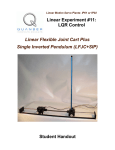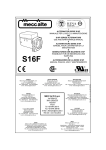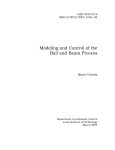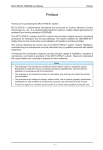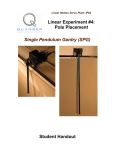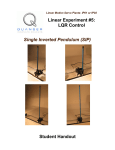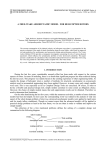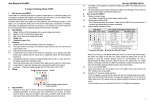Download Vibration Control Active Mass Damper - One Floor (AMD-1)
Transcript
Linear Motion Servo Plant: AMD-1 Linear Experiment #9: Vibration Control Active Mass Damper - One Floor (AMD-1) Student Handout Vibration Control Laboratory – Student Handout Table of Contents 1. Objectives............................................................................................................................1 2. Prerequisites.........................................................................................................................2 3. References............................................................................................................................2 4. Experimental Setup..............................................................................................................3 4.1. Main Components........................................................................................................3 4.2. Wiring..........................................................................................................................3 5. Controllers Design Specifications.......................................................................................4 5.1. Excitation Mode: PV Controller Design Specifications..............................................4 5.2. Active Mass Damping (AMD) Mode..........................................................................4 5.2.1. State-Feedback Design: Pole Locations...............................................................5 5.2.2. Full-Order State Observer Design: Pole Locations..............................................5 6. Pre-Lab Assignments...........................................................................................................6 6.1. Assignment #1: Proportional-Velocity (PV) Controller Design..................................6 6.2. AMD-1 System Representation and Notations............................................................8 6.3. Assignment #2: Determination of the AMD-1 System's Linear Equations Of Motion (EOM).................................................................................................................................9 6.4. Assignment #3: AMD-1 State-Space Representation..................................................9 6.5. Assignment #4: Full-Order Observer.........................................................................11 7. In-Lab Procedure................................................................................................................13 7.1. Experimental Setup And Wiring................................................................................13 7.2. Real-Time Implementation Of The AMD-1 Switching-Mode Controller.................13 7.2.1. Objectives...........................................................................................................13 7.2.2. Experimental Procedure.....................................................................................13 Appendix A. Nomenclature...................................................................................................22 Appendix B. AMD-1 Equations Of Motion (EOM)..............................................................25 Document Number: 561 ! Revision: 02 ! Page: i Vibration Control Laboratory – Student Handout 1. Objectives As illustrated in Figure 1, below, the purpose of the AMD-1 experiment is to design a control system that dampens the vibration of a bench-scale building-like tall structure using an Active Mass Damper (AMD) mounted at the top. The Active Mass Damper - One Floor (AMD-1) experiment can be used in earthquake mitigation studies and to investigate Control-Structure Interaction (CSI). It is conceptually similar to active mass dampers used to suppress vibrations in tall structures (e.g. high-rise buildings) and to protect not only against earthquakes but also, for example, strong winds (e.g. hurricanes). The Active Mass Damper – One Floor (AMD-1) plant is illustrated in Figure 1, below, and is fully described in Reference [1]. This laboratory takes advantage that the dynamics of the active mass (i.e. cart) are tightly coupled to these of the building-like structure to which it is attached. Therefore, the active mass can either be used to excite or to dampen the flexible structure vibration. The purpose of the AMD-1 laboratory is to design a switching-mode control system that first excites the vibration mode of the onestory structure and then dampens the structure oscillation. Figure 1 AMD-1 Experiment During the course of this experiment, you will become familiar with the design of Proportional-plus-Velocity (PV) position controller to drive the linear cart (i.e. active mass) such that it excites the flexible structure natural vibrations. Then a vibration reduction control strategy will be designed in order to dampen the structure oscillations. Such a AMD control strategy will be implemented using a full-state feedback law based on a full-order observer. Pole placement will be used to tune the control scheme. Document Number: 561 ! Revision: 02 ! Page: 1 Vibration Control Laboratory – Student Handout At the end of the session, you should know the following: How to mathematically model the IP01- or IP02-based linear servo plant from first principles in order to obtain the open-loop transfer function, in the Laplace domain. How to design and tune a Proportional-Velocity (PV) position controller to meet the required design specifications. How to mathematically model the Active Mass Damper – One Floor (AMD-1) plant using the Lagrange's method and to obtain its state-space representation. How to design and tune a full-order state-observer based on the structure's acceleration feedback signal. How to design and tune a state-feedback controller satisfying the closed-loop system's desired design specifications. How to implement in real-time the total AMD-1 mode-switching (between vibration excitation and active mass damping) control scheme and evaluate its actual performance. 2. Prerequisites To successfully carry out this laboratory, the prerequisites are: i) To be familiar with your Active Mass Damper – One Floor (AMD-1) main components (e.g. actuator, sensors), your data acquisition card (e.g. Q8, MultiQ), and your power amplifier (e.g. UPM), as described in References [1], [3], [4], and [5]. ii) To have successfully completed the pre-laboratory described in Reference [2]. Students are therefore expected to be familiar in using WinCon to control and monitor the plant in real-time and in designing their controller through Simulink, as detailed in Reference [6]. iii) To have successfully completed the laboratory described in Reference [7]. iv) To be familiar with the complete wiring of your Active Mass Damper – One Floor (AMD-1) plant, as per dictated in Reference [1]. v) To be familiar with the design theory of full-order state observers, as described for example in Reference [8]. 3. References [1] [2] [3] [4] [5] [6] [7] Active Mass Damper – One Floor (AMD-1) User Manual. IP01 and IP02 – Linear Experiment #0: Integration with WinCon – Student Handout. IP01 and IP02 User Manual. Data Acquisition Card User Manual. Universal Power Module User Manual. WinCon User Manual. IP01 and IP02 - Linear Experiment #1: PV Position Control – Student Handout. Document Number: 561 ! Revision: 02 ! Page: 2 Vibration Control Laboratory – Student Handout [8] P. R. Bélanger. Control Engineering: A Modern Approach. 1995, Saunders College Publishing. 4. Experimental Setup 4.1. Main Components To setup this experiment, the following hardware and software are required: Power Module: Data Acquisition Board: Quanser UPM 1503 / 2405, or equivalent. Quanser Q8 / MultiQ PCI / MQ3, or equivalent. Active Mass Damper Plant: Quanser Active Mass Damper – One Floor (AMD-1), as represented in Figure 1, above. Real-Time Control Software: The WinCon-Simulink-RTX configuration, as detailed in Reference [6], or equivalent. For a complete and detailed description of the main components comprising this setup, please refer to the manuals corresponding to your configuration. 4.2. Wiring To wire up the system, please follow the default wiring procedure for your Active Mass Damper – One Floor (AMD-1) system, as fully described in Reference [1]. When you are confident with your connections, you can power up the UPM. Document Number: 561 ! Revision: 02 ! Page: 3 Vibration Control Laboratory – Student Handout 5. Controllers Design Specifications The Active Mass Damper – One Floor (AMD-1) experiment essentially consists of a switching-mode controller using a pre-defined logic sequence to alternate between a mode of repeatable structural excitation and the Active Mass Damping (AMD) mode to stiffen the structure. Each mode is achieved through its own closed-loop control scheme. However, the power amplifier (e.g. UPM) should not go into saturation in any case. Also both controllers control effort, which is proportional to the motor input voltage Vm, should stay within the system's physical limitations. 5.1. Excitation Mode: PV Controller Design Specifications The (self-)excitation mode uses the active mass to generate a repeatable disturbance to the AMD-1's building-like structure. In this case, the linear cart (i.e. active mass) control loop consists of a Proportional-Velocity (PV) position controller. In the present laboratory (i.e. the pre-lab and in-lab sessions), you will design and implement a control strategy based on the Proportional-Velocity (PV) control scheme, in order for your linear cart system to satisfy the following performance closed-loop requirements: 1. The cart position Percent Overshoot, PO, should be less than 10%, i.e.: PO ≤ 10 [ "%" ] [1] 2. The time to first peak should be less than 150 ms, i.e.: tp ≤ 0.15 [ s ] [2] 5.2. Active Mass Damping (AMD) Mode In the Active Mass Damping (AMD) mode, the linear cart is controlled by using a statefeedback law based on a full-order observer. This time around, the purpose of the control strategy is to dampen the AMD-1 top floor oscilations (created in the excitation mode) by stiffening the structure. The general AMD design requirements are expressed below in terms of settling time and decayed amplitude of the floor deflection (xf) for an initial deflection of around 30 mm: ts ≤ 1.0 [ s ] xf ≤ 1.5 [ mm ] for Document Number: 561 ! Revision: 02 ! Page: 4 Vibration Control Laboratory – Student Handout The particular pole placements presented in the following by Equations [3] and [4] were chosen for the AMD closed-loop system to meet the specifications stated above. 5.2.1. State-Feedback Design: Pole Locations Determine the AMD-1 full-state feedback gain vector, K, such that the closed-loop poles (i.e. eigenvalues) due to the state-feedback law are placed at the following locations: −6 + 15 j, −6 − 15 j, -8, -16 [3] 5.2.2. Full-Order State Observer Design: Pole Locations However in order to be based on a full-state feedback (i.e. all structural displacements and velocities) law, the AMD-1's active structural control strategy should be based on a state observer. This is explained by the fact that the AMD-1's floor deflection and velocity are not measured directly, only its acceleration is. This particular design for the AMD-1 plant is due to full-scale real-life applications where floor deflections and velocities are difficult to measure directly. However, they can be estimated from acceleration measurements, since accelerometers provide an affordable and reliable way of sensing a building dynamic behaviour. Determine the AMD-1 full-order observer gain matrix, G, such that the closed-loop poles (i.e. eigenvalues) due to the observer error dynamics are placed at the following locations: -20, -25, -30, -35 [4] Comparing Equations [3] and [4], it can be noted that the dynamics of the observer error (i.e. rate at which the estimation error goes to zero) are at least three times faster (i.e. farther to the left in the s-plane) than the plant itself. This should ensure that the estimator does not interfere with the plant's dynamics. Document Number: 561 ! Revision: 02 ! Page: 5 Vibration Control Laboratory – Student Handout 6. Pre-Lab Assignments 6.1. Assignment #1: Proportional-Velocity (PV) Controller Design In this design procedure for the PV controller, the one-floor flexible structure on top of which the linear cart is mounted is ignored. The system is considered to consist of the IP01or IP02-based linear servo plant alone. A schematic of the AMD-1 linear cart system's input and output is represented in Figure 7, below. Figure 2 The AMD-1 Linear Cart Input and Output 1. Based on your previous work from Reference [7], write down the open-loop transfer function of your IP01- or IP02-based system, Gc(s), as defined below: G c( s ) = xc( s ) [5] Vm( s ) 2. The Proportional-Velocity (PV) position controller implemented in this lab for your linear servo plant introduces two corrective terms: one is proportional (by Kp) to the cart position error while the other is proportional (by Kv) to the cart velocity. Equation [6], below, expresses the resulting PV control law: d Vm( t ) = Kp ( xc_d( t ) − xc( t ) ) − Kv xc( t ) d t [6] 3. Quickly re-iterate your previous work from Pre-Lab Assignment #3 (i.e. the PV Document Number: 561 ! Revision: 02 ! Page: 6 Vibration Control Laboratory – Student Handout Controller Design Section) of Reference [7] in order to determine the two PV controller's gains, Kp and Kv, as functions of the second-order system's characteristic parameters ωnc and ζc. 4. Using the two Hint formulae provided below, express ωnc and ζc as functions of the two PV design specifications previously defined, PO and tp. Hint formula #1: PO = 100 e − πζ 2 1 − ζ c Hint formula #2: π tp = 2 ωnc 1 − ζ c c [7] [8] 5. Determine the values of ωnc and ζc corresponding to the desired PV design specifications, as defined previously. Determine, then, from your results the numerical values of Kp and Kv satisfying the desired time requirements of your closed-loop PV-plus-cart system. Document Number: 561 ! Revision: 02 ! Page: 7 Vibration Control Laboratory – Student Handout 6.2. AMD-1 System Representation and Notations A schematic of the Active Mass Damper – One Floor (AMD-1) plant is represented in Figure 3, below. The AMD-1 scaled building is a Single-Degree-Of-Freedom (SDOF) structure (i.e. single story). The AMD-1 system's nomenclature is provided in Appendix A. As illustrated in Figure 3, the positive direction of horizontal displacement is towards the right when facing the system. Figure 3 Schematic of the AMD-1 Plant For small floor deflection angles, the AMD-1 "roof" is modelled as a standard linear springmass system, as represented in Figure 3 above. Using the system's specifications given in Reference [1], the floor assembly mass, Mf, can be calculated from: Mf = Mr + Mtf [9] The AMD-1's top floor linear stiffness constant Kf, for small angular structure oscillations, is given in Reference [1]. Kf models the lateral stiffness of the structure. However, it is consistent with the following relationship, obtained from the standard Ordinary Differential Equation (ODE) describing the free-oscillatory motion of a mass: Document Number: 561 ! Revision: 02 ! Page: 8 Vibration Control Laboratory – Student Handout Kf = 4 ( Mf + Mc ) π2 fn 2 [10] In the presented modelling approach, the structure viscous damping coefficient, Bf, is neglected. 6.3. Assignment #2: Determination of the AMD-1 System's Linear Equations Of Motion (EOM) The determination of the AMD-1's structure-plus-cart equations of motion is derived in Appendix B. If Appendix B has not been supplied with this handout, derive the system's equations of motion following the system's schematic and notations previously defined and illustrated in Figure 3. Also, put the resulting EOM under the following format: ∂ ∂ ∂2 ∂ 2 x = x xc, xf, xc, xf, Fc [11] 2 c 2 c ∂t ∂t ∂t ∂t and ∂2 ∂ ∂ ∂ 2 x = x xc, xf, xc, xf, Fc [12] 2 f 2 f ∂t ∂t ∂t ∂t Hint #1: By neglecting the Coulomb (a.k.a. static) friction of the cart system, the two EOM should be linear. They represent a pure spring-mass-damper system. Hint #2: You can use the method of your choice to model the system's dynamics. However, the modelling developed in Appendix B uses the energy-based Lagrangian approach. In this case, since the system has two Degrees-Of-Freedom (DOF), there should be two Lagrangian coordinates (a.k.a. generalized coordinates). The chosen two coordinates are namely: xc and xf. Also, the input to the system is defined to be Fc, the linear force applied by the motorized cart. 6.4. Assignment #3: AMD-1 State-Space Representation In order to design and implement a state-feedback controller for our system, a state-space representation of that system needs to be derived. Moreover, it is reminded that state-space matrices, by definition, represent a set of linear differential equations that describe the system's dynamics. Since the two EOM of the AMD-1, as found in Assignment #2, should al- Document Number: 561 ! Revision: 02 ! Page: 9 Vibration Control Laboratory – Student Handout ready be linear, they can be written under the state-space matrices representation. Answer the following questions: 1. Determine from the system's two equations of motion, the state-space representation of our AMD-1 plant. That is to say, determine the state-space matrices A, B, C, and D verifying the following relationships: ∂ X=AX+BU Y=CX+DU and [13] ∂t where X is the system's state vector. In practice, X is often chosen to include the generalized coordinates as well as their first-order time derivatives. In our case, X is defined such that its transpose is as follows: d d X T = xc( t ), xf( t ), xc( t ), xf( t ) [14] dt dt Furthermore, it is reminded that the system's measured output vector is: d2 Y T = xc( t ), 2 xf( t ) [15] dt Also in Equation [13], the input U is set in a first time to be Fc, the driving force of the linear motorized cart. Thus we have: U = Fc [16] As a remark, it can be seen from Equations [15] and [16] that the AMD-1 system consists of two outputs for one input. 2. From the system's state-space representation previously found, transform the state-space matrices for the case where the system's input U is equal to the linear cart's DC motor voltage Vm, instead of the linear force Fc. The system's input U can now be expressed by: U = Vm [17] Hint: In order to convert the previously found force equation state-space representation to voltage input, it is reminded that the driving force, Fc, generated by the DC motor and acting on the cart through the motor pinion has already been determined in previous laboratories. As shown for example in Equation [B.9] of Reference [7], Fc can be expressed by: 2 d ηg Kg ηm Kt Km xc( t ) η K η K V + g g m t m dt [18] Fc = − 2 R r m mp Rm r mp Document Number: 561 ! Revision: 02 ! Page: 10 Vibration Control Laboratory – Student Handout 3. Evaluate the matrices A, B, C, and D found in question 2, that is to say in case the system's input U is equal to the cart's DC motor voltage, as expressed in Equation [16]. Hint: Evaluate state-space matrices by using the model parameter values given in Reference [1]. Ask your laboratory instructor what system configuration you are going to use in your in-lab session. In case no additional information is provided, assume that the two additional masses are mounted on top of the linear cart. 4. Calculate the open-loop poles from the system's state-space representation, as previously evaluated in question 3. Is it stable? What is the type of the system? What can you infer regarding the system's dynamic behaviour? Do you see the need for a closed-loop controller? Explain. Hint: The characteristic equation of the open-loop system can be expressed as shown below: det( s I − A ) = 0 [19] where det() is the determinant function, s is the Laplace operator, and I the identity matrix. Therefore, the system's open-loop poles can be seen as the eigenvalues of the state-space matrix A. 6.5. Assignment #4: Full-Order Observer Since all the states contained in X, as defined in Equation [14], cannot be directly measured (e.g. xf), a state observer needs to be built to estimate them. The system's variables directly measured are expressed in the output vector defined in Equation [15]. This laboratory focuses on the design of a full-order observer. The full-order observer structure is defined as follows: ∂ X = A Xo + B U + G ( Y − Yo ) ∂t o [20] and: Yo = C Xo + D U [21] It can be seen from Equations [20] and [21] that the state observer has for inputs the system's input(s) and output(s) and calculates as outputs the states estimates. The observer is basically a replica of the actual plant with a corrective term G(Y-Yo) multiplied by the observer gain matrix. Document Number: 561 ! Revision: 02 ! Page: 11 Vibration Control Laboratory – Student Handout The obtained estimated state vector can then be used for state-feedback law, as expressed below: ( U = Vm ) = −K Xo [22] Let us define the estimation error vector as follows: Xe = X − Xo [23] Using Equations [13], [20], [21], and [23], the estimation error dynamically behaves accordingly to the following relationship: ∂ X = ( A − G C ) Xe ∂t e [24] Therefore from Equation [24], the estimation error will asymptotically go to zero if and only if (A-GC) is stable, that is to say iff G is determined such as (A-GC) has all its eigenvalues in the left-hand plane. However, a theorem shows that if (A,C) is observable, then (A-GC) can always be made stable by a proper choice of G. Therefore, it is possible to estimate the state(s) of a system if and only if that system is observable. Please refer to your in-class notes as required. Determine whether (A,C) is observable. Hint: By definition, a system is observable iff its observability matrix has full rank (i.e. number of states). The observability matrix is defined as follows: Wo = [ C, C A, C A 2, C A 3 ] T [25] Document Number: 561 ! Revision: 02 ! Page: 12 Vibration Control Laboratory – Student Handout 7. In-Lab Procedure 7.1. Experimental Setup And Wiring Even if you do not configure the experimental setup entirely yourself, you should be at least completely familiar with it and understand it. If in doubt, refer to References [1], [4], [5], and/or [6]. The first task upon entering the lab is to ensure that the complete system is wired as fully described in Reference [1]. You should be familiar with the complete wiring and connections of your Active Mass Damper – One Floor (AMD-1) system. If you are still unsure of the wiring, please ask for assistance from the Teaching Assistant assigned to the lab. When you are confident with your connections, you can power up the UPM. You are now ready to begin the lab. 7.2. Real-Time Implementation Of The AMD-1 SwitchingMode Controller 7.2.1. Objectives To implement in real-time with WinCon the previously designed PV position controller in order to command your actual AMD-1 linear servo plant. To design through pole placement a full-order observer for the actual AMD-1 system. To design through pole placement a state-feedback law for the actual AMD-1 system by using the obtained estimated state vector. To implement in real-time with WinCon the previously determined observer-based state-feedback to dampen the vibration of the AMD-1 structure by appropriately driving the active mass on top of it. 7.2.2. Experimental Procedure Please follow the steps described below: Step1. If you have not done so yet, you can start-up Matlab now. Depending on your system configuration, open the Simulink model file of name type q_amd1_ZZ.mdl or q_amd1_e_ZZ.mdl, where ZZ stands for either for 'mq3', 'mqp', 'q8', or 'nie'. Ask the TA assigned to this lab if you are unsure which Simulink model is to be used in the lab. You should obtain a diagram similar to the one shown in Figure 4, below. Document Number: 561 ! Revision: 02 ! Page: 13 Vibration Control Laboratory – Student Handout Figure 4 Real-Time Implementation of the AMD-1 Controller In order to use your actual AMD-1 system, the controller diagram directly interfaces with your system hardware, as shown in Figure 5, below. Figure 5 Interface Subsystem to the Actual AMD-1 Plant Using the MultiQ-PCI Card Document Number: 561 ! Revision: 02 ! Page: 14 Vibration Control Laboratory – Student Handout To familiarize yourself with the diagram, it is suggested that you open the model subsystems to get a better idea of their composing blocks as well as take note of the I/O connections. The real-time model, shown in Figure 4 above, implements a switching-mode controller. A pre-defined Mode-Switching Sequence alternatively controls the linear cart using either a Proportional-Velocity (PV) position controller or an observer-based statefeedback law. In short, the PV controller is mostly used in the excitation mode to selfexcite the vibration in the building-like structure. On the other hand, the state-feedback law is designed to dampen the structure oscillation by driving the active mass (i.e. cart). Both control loops are the actual implementations of the pre-laboratory assignments previously carried out. Opening the Disturbance Setpoint sub-system should show a diagram similar to Figure 6. This diagram generates the cart position setpoint to follow in order to best excite the AMD-1's flexible structure. The setpoint basically consists of one full period of a sine wave of frequency 2.5 Hz (i.e. for a duration of 0.4 seconds) and amplitude 6 cm. The sinusoidal excitation's frequency has been chosen accordingly to the structure's natural frequency, as given in Reference [1]. This excitation repeats itself every 10 seconds. Figure 6 Excitation Mode: Cart Position Setpoint Generation Figure 4, above, also includes a subsystem named PV Position Controller, which implements your linear cart PV controller's two feedback loops. This PV controller is based on the actual measurement of the cart position (coming from the encoder). The obtained position signal is then differentiated and low-pass filtered to attenuate any high-frequency noise. Document Number: 561 ! Revision: 02 ! Page: 15 Vibration Control Laboratory – Student Handout Figure 7 Diagram used for the Real-Time Implementation of the AMD-1 Cart PV Position Controller CAUTION: The velocity signal used in the control inner-loop of the actual linear cart is obtained by first differentiating the position signal (i.e. encoder counts), and then by low-pass filtering the obtained signal in order to eliminate its high frequency content. As a matter of fact, high-frequency noise, which is moreover amplified during differentiation, causes long-term damage to the motor. To protect your DC motor, the recommended cut-off frequency is 50 Hz. When the Mode-Switching Sequence block outputs "2" instead of "1", that turns on the Active Mass Damping (AMD) capabilities of the linear cart located on top of the structure. The AMD behaviour is achieved by implementing a full-order-observerbased state-feedback control loop, as illustrated in Figure 4 above by the orange blocks. The full-order state observer defined by Equations [20] and [21] is implemented in the subsystem called Full-Order Observer and depicted in Figure 8, below. Document Number: 561 ! Revision: 02 ! Page: 16 Vibration Control Laboratory – Student Handout Figure 8 Actual AMD-1 Full-Order State Observer Step2. Before being able to run the actual control loops, the different controller gains must be initialized in the Matlab workspace, since they are to be used by the Simulink controller diagram. Start by running the Matlab script called setup_lab_amd1.m. However, ensure beforehand that the CONTROLLER_TYPE flag is set to 'MANUAL'. This file initializes all the AMD-1 model parameters, user-defined parameters, and AMD-1's state-space matrices, as defined in pre-lab Assignment #3. First, the two PV controller gains, Kp and Kv, calculated in pre-lab Assignment #1 and satisfying the desired time requirements must be entered in the Matlab workspace. To assign Kp and Kv, type their values in the Matlab command window by following the Matlab notations used for the controller gains as presented in Table A.2 of Appendix A. Second, the state-feedback gain vector, K, must be calculated and entered in the Matlab workspace. Use Matlab to carry out the pole-placement calculations satisfying the design requirement expressed by Equation [3]. Third and last, the observer gain matrix, G, must also be calculated and entered in the Matlab workspace. Use Matlab to carry out the pole-placement calculations satisfying the design requirement expressed by Equation [4]. Refer to your in-class notes regarding the full-order observer design theory as needed. Hint: Pole-placement calculations can be achieved in Matlab by using the function 'place()' or 'acker()'. CAUTION: Document Number: 561 ! Revision: 02 ! Page: 17 Vibration Control Laboratory – Student Handout Have your lab assistant check your controller gain values. Do not proceed to the next step without his or her approval. Step3. You are now ready to go ahead with compiling and running your actual switching-mode controller for the AMD-1 system. First, compile the real-time code corresponding to your diagram, by using the WinCon | Build option from the Simulink menu bar. After successful compilation and download to the WinCon Client, you should see the green START button available on the WinCon Server window. You are now in a position to use WinCon Server to run in real-time your actual closed-loop system. CAUTION: Before starting your actual controller, manually move the linear cart (located on the top floor) to the middle of the track (i.e. mid-stroke position). Also make sure that the AMD-1 "ground" floor is properly clamped/mounted to a table. Step4. You can now run your Active Mass Damper experiment on the actual AMD-1 plant by clicking on the START/STOP button of the WinCon Server window. This should start the AMD-1 control sequence, as illustrated by real data in Figure 9, below. Figure 9 AMD-1 Actual Experiment As previously mentioned, the AMD-1's linear cart is commanded by a switchingmode controller. In excitation mode (i.e. Mode Switching Sequence equals to "1", or AMD OFF), the cart is subject to the PV position controller. In Active Mass Damping Document Number: 561 ! Revision: 02 ! Page: 18 Vibration Control Laboratory – Student Handout (AMD) mode (i.e. Mode Switching Sequence equals to "2", or AMD ON), the cart is subject to an observer-based state-feedback controller. The AMD-1 experiment is setup such that the cart excites the structural dynamics once every 10 seconds by following a full-period sinusoidal excitation at the structure's natural frequency. This is illustrated in Figure 9, above, by Excitation #1 and Excitation #2. This initial and repeatable mass movement causes a vibration in the AMD-1 flexible structure which persists at its natural rate if the AMD mode/controller is not switched on, as depicted by the first 10 seconds in Figure 9. The AMD mode is only turned on after the second structural excitation. This causes the top floor vibrations to dampen out quickly, as shown by the last 10 seconds in Figure 9. In order to observe the structure natural behaviour versus its actively damped (or controlled) behaviour, the AMD mode is only switched on once every over 10-second period, while the excitation disturbance repeats itself once every 10-second period. Step5. In order to observe the system's real-time responses from the actual system, open the following WinCon Scopes: xf_ddot (m/s^2), xf (mm), and PV Position Controller/PV Control: xc (mm). You should now be able to monitor on-the-fly, as the system goes through the synchronized excitation/AMD-control sequences, the measured top floor acceleration, the controller mode, the estimated floor deflection, and the linear cart setpoint and actual position, respectively. Furthermore, you can also open the sink Vm (V) in a WinCon Scope. This allows you to monitor on-line the actual commanded motor voltage, which is proportional to the control effort spent, sent to the power amplifier. Hint #1: To open a WinCon Scope, click on the Scope button of the WinCon Server window and choose the display that you want to open (e.g. xf_ddot (m/s^2)) from the selection list. Hint #2: For a good visualization of the actual system responses, you should set the WinCon scope buffer to 20 seconds. To do so, use the Update | Buffer... menu item from the desired WinCon scope. Step6. Over an example run of 20 seconds, your actual AMD-1's floor acceleration and control mode sequences should look similar to the ones displayed in Figure 10, below. Corresponding to the same experimental run, the time recors of the AMD-1's cart measured position and excitation setpoint are depicted in Figure 11, below. Document Number: 561 ! Revision: 02 ! Page: 19 Vibration Control Laboratory – Student Handout Figure 10 AMD-1 Floor Actual Acceleration And Controller Mode Figure 11 AMD-1 Cart Actual Position Response And Excitation Setpoint Document Number: 561 ! Revision: 02 ! Page: 20 Vibration Control Laboratory – Student Handout Step7. Compare the structure's actively damped and natural behaviours in terms of settling time and amplitude of the floor deflection (xf) and/or acceleration (xf_ddot). Assess the actual performance of your Active Mass Damping controller. Measure your floor estimated deflection response settling time. Are the design specifications satisfied? Explain. Hint: In order to accurately measure a signal amplitude and time values from your WinCon Scope plot, you can first select Freeze Plot from the WinCon Scope Update menu and then reduce the window's time interval by opening the Set Time Interval input box through the Scope's Axis | Time... menu item. You should now be able to scroll through your plotted data. Alternatively, you can also save your Scope trace(s) to a Matlab file for further data processing. Do so by using the File | Save selection list from the WinCon Scope menu bar. Step8. If your AMD-1 responses do not meet the desired design specifications, review your PV and/or observer and/or state-feedback gain calculations and/or alter the closed-loop pole locations until they do. If you are still unable to achieve the required performance level, ask your T.A. for advice. Step9. Include in your lab report your final values for Kp, Kv, K, and G as well as the resulting plots of the actual system responses (e.g. floor acceleration, estimated deflection, controller mode, cart position, command voltage). Ensure to properly document all your results and observations. Step10. You can move on and begin your report for this lab. Document Number: 561 ! Revision: 02 ! Page: 21 Vibration Control Laboratory – Student Handout Appendix A. Nomenclature Table A.1, below, provides a complete listing of the symbols and notations used in the Active Mass Damper – One Floor (AMD-1) mathematical modelling, as presented in this laboratory. The numerical values of the system parameters can be found in Reference [1]. Symbol Description Matlab / Simulink Notation Mtf Structure Top Floor Mass Mtf Mr Rack Mass Mr fn Floor (a.k.a. Roof) Natural Frequency fn Kf Floor (a.k.a. Roof) Linear Stiffness Constant Kf Mf Floor/Roof (i.e. floor 1 + rack) Total Mass Mf xf Floor Horizontal Deflection (Relative To The Ground) xf ∂ x ∂t f Floor Horizontal Velocity (Relative To The Ground) xf_dot ∂2 x ∂t2 f Floor Horizontal Acceleration (Relative To The Ground) xf_ddot Mc Total Mass of the Cart System Mc Vm Cart Motor Armature Voltage Vm Im Cart Motor Armature Current Im Rm Cart Motor Armature Resistance Rm Lm Cart Motor Armature Inductance Lm Kt Cart Motor Torque Constant Kt ηm Cart Motor Efficiency Km Cart Back-ElectroMotive-Force (EMF) Constant Km Jm Cart Rotor Moment of Inertia Jm Beq Equivalent Viscous Damping Coefficient, as seen at the Motor Pinion Beq Kg Cart Planetary Gearbox Gear Ratio Kg ηg Cart Planetary Gearbox Efficiency Eff_g Eff_m Document Number: 561 ! Revision: 02 ! Page: 22 Vibration Control Laboratory – Student Handout Symbol Description Matlab / Simulink Notation rmp Cart Motor Pinion Radius r_mp Fc Cart Driving Force Produced by the Motor (i.e. Control Force) Fc xc Cart Linear Position (Relative To The Floor) xc ∂ x ∂t c Cart Linear Velocity (Relative To The Floor) xc_dot VT Total Potential Energy of the AMD-1 System Ttc Cart's Translational Kinetic Energy Trc Cart Rotor's Rotational Kinetic Energy Ttf Structure Top Floor's Translational Kinetic Energy TT Total Kinetic Energy of the AMD-1 System Qxc Generalized Force Applied on the Generalized Coordinate xc Qxf Generalized Force Applied on the Generalized Coordinate xf Table A.1 AMD-1 Model Nomenclature Table A.2, below, provides a complete listing of the symbols and notations used in the PV position controller design, as used in this laboratory. Symbol PO tp Description Matlab / Simulink Notation Percent Overshoot PO Peak Time tp ωnc Cart Undamped Natural Frequency wn_c ζc Cart Damping Ratio zeta_c Kp Cart Proportional Gain Kp Kv Cart Velocity Gain Kv xc_d Cart Desired Position (i.e. Reference Signal) xc_d Document Number: 561 ! Revision: 02 ! Page: 23 Vibration Control Laboratory – Student Handout Symbol Description t Continuous Time s Laplace Operator Matlab / Simulink Notation Table A.2 PV Cart Controller Nomenclature Table A.3, below, provides a complete listing of the symbols and notations used in the fullorder observer and state-feedback controller design, as presented in this laboratory. Symbol Description A, B, C, D State-Space Matrices of the AMD-1 System Matlab / Simulink Notation A, B, C, D X Actual State Vector X Y Actual Output Vector Y U System Input U K State-Feedback Gain Vector K Xo Estimated State Vector Xo Yo Estimated Output Vector Yo G Full-Order State Observer Gain Matrix G Wo Observer's Observability Matrix Wo Xe State Vector Estimation Error Xe Table A.3 Control Loop Nomenclature Document Number: 561 ! Revision: 02 ! Page: 24 Vibration Control Laboratory – Student Handout Appendix B. AMD-1 Motion (EOM) Equations Of This Appendix derives the general dynamic equations of the Active Mass Damper – One Floor (AMD-1) system. The Lagrange's method is used to obtain the dynamic model of the system. In this approach, the single input to the system is considered to be Fc. Furthermore, it is reminded that the reference frame used is defined in Figure 3, on page 8. To carry out the Lagrange's approach, the Lagrangian of the system needs to be determined. This is done through the calculation of the system's total potential and kinetic energies. Let us first calculate the system's total potential energy VT. The potential energy in a system is the amount of energy that that system, or system element, has due to some kind of work being, or having been, done to it. It is usually caused by its vertical displacement from normality (gravitational potential energy) or by a spring-related sort of displacement (elastic potential energy). Here, there is no gravitational potential energy since both AMD-1 cart and structure are assumed to stay at a constant elevation (i.e. no vertical displacement from normality), for small angular structure oscillations. However as represented in Figure 3, the AMD-1 top floor is modelled as a linear spring-mass system. Therefore, the AMD-1's total potential energy is only due to its elastic potential energy. It results that the total potential energy of the AMD-1 plant can be fully expressed as: 2 1 VT = Kf xf( t ) [B.1] 2 It can be seen from Equation [B.1] that the total potential energy can be expressed in terms of the system's generalized coordinates alone. Let us now determine the system's total kinetic energy TT. The kinetic energy measures the amount of energy in a system due to its motion. Here, the total kinetic energy is the sum of the translational and rotational kinetic energies arising from the motorized linear cart (since the cart's direction of translation is orthogonal to that of the rotor's rotation) and the translational kinetic energy of the flexible structure's floor. In other words, the total kinetic energy of the AMD-1 system can be formulated as below: TT = Ttc + Tr c + Ttf [B.2] First, the translational kinetic energy of the motorized cart can be expressed as a function of its centre of gravity's linear velocity, as shown by the following equation: 1 d d Ttc = Mc xc( t ) + xf( t ) 2 dt dt 2 [B.3] Document Number: 561 ! Revision: 02 ! Page: 25 Vibration Control Laboratory – Student Handout Second, the rotational kinetic energy due to the cart's DC motor can be characterized by: d Jm Kg xc( t ) 1 dt Tr c = 2 2 rmp 2 2 [B.4] Third and last, the structure floor's translational kinetic energy can be characterized as follows: 1 d Ttf = Mf xf( t ) 2 dt 2 [B.5] Thus by replacing Equations [B.3], [B.4], and [B.5] into Equation [B.2], the system's total kinetic energy results to be such as: 2 2 J K 1 1 m g d + M d x (t) d x (t) x ( ) TT = Mc + t c dt f 2 r 2 dt c 2 dt c mp [B.6] 1 1 d + Mc + Mf xf( t ) 2 dt 2 2 It can be seen from Equation [B.6] that the total kinetic energy can be expressed in terms of the generalized coordinates' first-time derivatives. Let us now consider the Lagrange's equations for our system. By definition, the two Lagrange's equations, resulting from the previously-defined two generalized coordinates, xc and xf, have the following formal formulations: ∂ ∂ L = Qx L − ∂xc d [B.7] c ∂t ∂ x ( t ) c d t and: ∂ ∂ L = Qx L − ∂ xf d [B.8] f ∂t ∂ x ( t ) dt f In Equations [B.7] and [B.8], above, L is called the Lagrangian and is defined to be equal to: Document Number: 561 ! Revision: 02 ! Page: 26 Vibration Control Laboratory – Student Handout L = TT − VT [B.9] For our system, the generalized forces can be defined as follows: d Qx ( t ) = 0 Qx ( t ) = Fc( t ) − Beq xc( t ) and [B.10] f d t c It should be noted that the (nonlinear) Coulomb friction applied to the linear cart has been neglected. Furthermore, the viscous damping force applied to the structure floor has also been neglected. Calculating Equation [B.7] results in a more explicit expression for the first Lagrange's equation, such that: 2 2 2 d ( Mc rmp + Jm Kg ) 2 xc( t ) 2 dt + M d x ( t ) = F − B d x ( t ) [B.11] 2 c 2 f c eq dt c d t rmp Likewise, calculating Equation [B.8] also results in a more explicit form for the second Lagrange's equation, as shown below: d2 d2 Mc 2 xc( t ) + ( Mc + Mf ) 2 xf( t ) + Kf xf( t ) = 0 [B.12] dt dt Finally, solving the set of the two Lagrange's equations, as previously expressed in Equations [B.11] and [B.12], for the second-order time derivative of the two Lagrangian coordinates results in the following two equations: 2 d 2 rmp ( −Mc Beq − Mf Beq ) xc( t ) rmp Mc xf( t ) Kf d d2 t x ( t ) = + 2 c 2 2 2 2 2 2 dt Mc rmp Mf + Jm Kg Mc + Jm Kg Mf Mc rmp Mf + Jm Kg Mc + Jm Kg Mf [B.13] 2 + rmp ( Mc Fc + Mf Fc ) 2 2 2 Mc rmp Mf + Jm Kg Mc + Jm Kg Mf and: Document Number: 561 ! Revision: 02 ! Page: 27 Vibration Control Laboratory – Student Handout 2 d 2 2 Mc Beq rmp xc( t ) ( Mc rmp + Jm Kg ) xf( t ) Kf d2 dt x ( t ) = − + 2 f 2 2 2 2 2 2 dt Mc rmp Mf + Jm Kg Mc + Jm Kg Mf Mc rmp Mf + Jm Kg Mc + Jm Kg Mf [B.14] − Mc Fc rmp 2 2 2 2 Mc rmp Mf + Jm Kg Mc + Jm Kg Mf Equations [B.13] and [B.14] represent the Equations Of Motion (EOM) of the system. It can be noticed, in the case of the AMD-1 system, that the EOM are linear. As a remark, if both Beq and Jm are neglected, Equations [B.13] and [B.14] become: Kf xf( t ) ( Mc + Mf ) Fc d2 x ( t ) = + [B.15] Mc M f Mf dt 2 c and: Kf xf( t ) Fc d2 x ( t ) = − − Mf Mf dt 2 f [B.16] Document Number: 561 ! Revision: 02 ! Page: 28






























